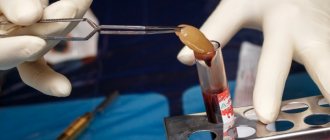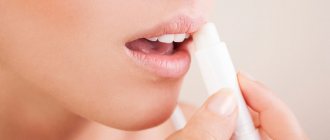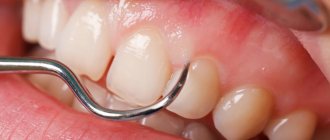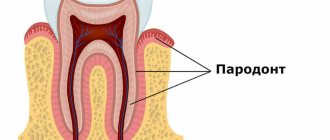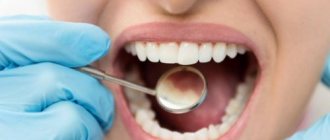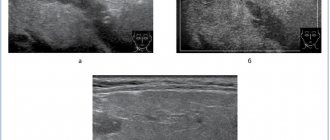In modern times, the development of dental diseases of varying severity forces doctors to find new techniques and methods for the prevention and treatment of these ailments. Plasmolifting of the gums will help solve the problem of inflammation, tooth decay and other symptomatic diseases of the oral cavity. This procedure has long been used in cosmetology, but it is also becoming popular in dentistry.
What is gum plasma lifting?
The term “plasmolifting” is used by dentists to refer to the injection of plasma with a high platelet content. It is separated from the patient’s own blood and injected into the gums. This autoplasma is rich in proteins, enzymes and hormones, and therefore promotes the regeneration of the oral mucosa and bone tissue. It triggers natural mechanisms of cell renewal and collagen growth, relieves inflammation, supplies tissues with oxygen and increases local immunity. As a result of the injection, it is possible to reduce or completely eliminate gum bleeding, return them to their original structure and color, and reduce tooth mobility.
Application of PRF membranes for bone tissue growth
Membranes from blood plasma are not used as a separate method of osteoplasty - they are not enough to replenish the size of bone tissue in full. But they are used to prepare jaw tissue for implantation when the bone structure is unsatisfactory, preventing the installation of an implant of sufficient length. Used as an addition to osteoplastic operations (independent or prior to implantation):
- sinus lift;
- alveolar ridge augmentation;
- bone block transplantation;
- guided bone regeneration.
Splitting of the alveolar ridge Increasing the volume of bone tissue in width by adding osteomaterial inside the alveolar process
Guided bone regeneration The lack of tissue is filled with a bone substitute, which is secured with a membrane. Use proprietary or synthetic materials
Sinus lifting A bone grafting method aimed at increasing the volume of bone tissue in the upper jaw in the area of the maxillary sinuses
When osteoplasty and implantation are performed simultaneously, the membrane accelerates the processes of osseointegration and stabilization of the implant. This is an effective way to activate the process of fusion of bone materials and implants with the jawbone, since the platelet concentrate contains tissue cell growth factors in large quantities. Membranes are also used for immediate installation of implants into the socket of an extracted tooth.
Plasmolifting procedure in dentistry
A small amount of blood is taken from the patient - about 10 milliliters, and platelet-rich plasma is separated from it using a centrifuge and test tubes. The doctor makes injections into the damaged areas of the gums:
- places of installation of implants and osteosynthesis;
- holes left after tooth extraction;
- sinus lift areas;
- and other areas of the oral cavity where there is inflammation.
The drug begins to act almost instantly, improving blood circulation and metabolism in cells.
Plasmolifting is a modern method of complex treatment of periodontal diseases
G. M. Fleisher , consultant physician, State Healthcare Institution "Regional Dental Clinic - Dental Center", two-time record holder of the Guinness World Book of Records (Lipetsk)
Inflammatory periodontal diseases represent one of the most pressing problems in dentistry, which has not only general medical but also social significance, which is due to the high prevalence, intensity of the process, subsequent formation of a chronic odontogenic focus of infection, tooth loss at a young age and adverse effects on the body.
According to various authors, periodontal pathology affects from 33 to 85% of the population. Such a high percentage of the prevalence of diseases indicates that this pathology is extremely difficult to treat, and it is almost impossible to eliminate the further development of the disease. This is due to the fact that periodontitis is characterized by a complex of pathological changes, which are based on steadily progressing and wave-like chronic inflammation, spreading from the gums to the lower parts of the periodontium.
The difficulty of treating inflammatory periodontal diseases lies in the fact that known and standard methods (antibacterial therapy and courses of local therapy) do not always give a positive result and a long period of remission. Therefore, to improve the quality of medical care for patients with periodontal pathology, it is necessary to introduce new innovative treatment methods into dental practice. Despite the presence of a large number of proposed methods (the use of osteoplastic materials, methods of targeted tissue regeneration, etc.), the problem of treating periodontitis remains relevant. Therefore, the widespread introduction of new technologies into dental practice is necessary to improve the quality of care for patients with periodontal disease. One of these methods today is the injection method using plasma obtained from the patient’s own blood - platelet autoplasma - which received the original name PlasmoliftingTM (“platelet-rich plasma” (Platelet-Rich Plasma - PRP). Close interest in autoplasma has previously This is all due to the fact that platelets contain numerous growth factors and cytokines that promote the regeneration of damaged tissues.Thanks to these factors, platelet plasma introduced into the tissue causes capillary sprouting, normalizes hemodynamics, tissue respiration, and metabolism.
The platelet-rich plasma membrane results from the activation of clotting factors. They also activate platelets (that is, they stimulate the release of growth factors by platelets)
PRP therapy is an injection method of local stimulation of regenerative processes in tissues. Its task is not just to relieve the inflammatory process, but to start the process of natural restoration of the color, shape and structure of the oral mucosa. The use of platelet-rich plasma (PRP) represents one of the few opportunities today to modulate and improve wound healing and combat infection without the use of drugs. The advantage of this method is plasma with a high platelet content, which can accelerate the restoration of bone, cartilage and epithelial tissue, since the regeneration process is universal and differs only in duration. Another advantage of this method is the improvement of microcirculation and metabolism, which stimulates local immunity. In addition, platelet-derived growth factors are unable to cause cancer because they are not mutagens.
At the same time, the process of strengthening bone tissue, the formation of a collagen and bone matrix occurs with the participation of bone morphogenetic collagen proteins, and local immunity is activated. The use of autoplasma eliminates the possibility of infection and allergic reactions. Platelet autoplasma is obtained using an EBA20 centrifuge manufactured by Andreas Hettich GmbH&Co, Germany (registration certificate FS No2009/04309, plasma lifting method; authors R. R. Akhmerov, R. F. Zarudiy). Similar studies have already been conducted in other areas of medicine and positive results have been obtained. For example, the effectiveness of tPA has been noted in the plastic surgery of mandibular defects of 5 cm or more using it in the form of grafting onto autogenous bone, and during sinus lifting - onto allogeneic bone; It is recommended to use tPA for the treatment of age-related skin atrophy in the form of injections.
The drug is injected into the area of the periodontal papillae and marginal gums at the rate of 0.1-0.2 ml per 3 mm2 and into the area of the transitional fold 0.3-0.5 ml per 1-2 teeth (a total of 3.5 ml of plasma per one dentofacial segment consisting of 6-8 teeth). The number of injections was 2-3 times in the same area with a break of 7-10 days. The time spent by the doctor on one procedure using one test tube was on average 7-30 minutes.
Plasmolifting is the injection of his own platelet-rich plasma into human tissue to stimulate regenerative processes in tissues.
Contraindications to the use of the method are malignant neoplasms, systemic blood diseases, mental illness, and a history of an allergic reaction to an anticoagulant (sodium heparin).
The day before blood sampling, patients are advised to follow a diet, not to overexert themselves physically, not to smoke or drink alcohol.
The material for plasma lifting is autoplasma, which contains platelets, hormones, proteins and vitamins in natural concentrations. In many ways, the consistency of the procedure is ensured by platelets and their growth factors (biologically active molecules of polypeptide origin), released by them when tissue integrity is violated. The use of platelet-rich plasma represents one of the few opportunities today to modulate and improve wound healing and resist infection without the use of drugs.
The main objectives of plasma lifting. Blood consists of intercellular substance (plasma) - a transparent liquid of pale yellow color (55% of the total mass of blood) and formed elements suspended in it (45%). The three main types are: red blood cells (erythrocytes), white blood cells (leukocytes) and platelets (platelets).
The use of autoplasma containing platelets is one of the possibilities for stimulating and improving tissue regeneration.
Autoplasma enriched with platelets and fibrin is an autogenous source of growth factors obtained by separating whole blood along a density gradient. It was found that when performing this function, platelets secrete special proteins - growth factors, which are biologically active molecules of polypeptide origin. They emit special signals that are perceived by receptors located on damaged cells. They, in turn, receive a signal and begin to stimulate the division of such cells. Thus, an increase in the level of platelets in the blood leads to an increase in the intensity of their effect on tissue regeneration. Plasma rich in platelets stimulates reparative processes, thereby reducing the time of epithelization. The mechanism of action of growth factors was studied decades ago in laboratories in many foreign countries. In the course of research, it was revealed that in the body, fibroblast cell division occurs hundreds of times more often and faster than the reproduction of the same cell culture in a test tube, which proves the stimulating effect of platelet-derived growth factors on tissue renewal.
The content of a large number of growth factors affects the components of epithelial, bone and connective tissue. Growth factors also trigger the formation of a young capillary network
Moreover, growth factors by their nature are proteins that are unable to cause mutagenic reactions, that is, the development of an oncological process. That is why injections of platelet autoplasma are a safe and effective way to accelerate tissue regeneration and the synthesis of collagen, elastin, and hyaluronic acid.
Autoplasma containing platelets is non-toxic and non-immunoreactive; it accelerates natural regeneration mechanisms due to the presence of growth factors in platelets that control natural regeneration mechanisms. The advantages of using autoplasma enriched with platelets and fibrin are safety (no risk of infectious diseases or immunogenic reactions) and non-invasiveness of the procedure itself, delivery of growth factors and cytokines directly to the wound area, speed and ease of preparation of the drug.
The functions of platelets are varied, but platelets have one of the most important functions - regenerating (due to growth factors). Platelets are cellular fragments of large progenitor cells of bone marrow megakaryocytes. The main function of platelets is to participate in blood coagulation. Platelets are responsible for blood clotting in the event of a violation of tissue integrity, releasing special proteins - growth factors, which are biologically active molecules of polypeptide origin.
Autoplasma is not antigenic in nature and does not threaten the patient with infection, since it is obtained from one’s own blood. Platelets containing growth factors are not mutagens and therefore cannot cause the development of tumors. The platelet-rich plasma membrane results from the activation of clotting factors. They also activate platelets (that is, they stimulate the release of growth factors by platelets).
The content of a large number of growth factors affects the components of epithelial, bone and connective tissue. Growth factors also trigger the formation of a young capillary network, and where vascular growth occurs, hemodynamics, metabolism and oxygenation will improve.
The platelet-rich plasma membrane results from the activation of clotting factors, which in turn activate platelets. In the first 10 minutes, platelets secrete up to 70% of growth factors, their complete release occurs within an hour, after which platelets continue to synthesize additional factors for 8 days. The platelets then die.
In all cases, plasma lifting allows you to speed up the process of epithelization and osseointegration, reducing the rehabilitation time for elderly patients and improving prognoses.
Histologically, this manifests itself as affecting not only epithelial tissue, but also connective tissue. The growth of the young capillary network is stimulated, hemodynamics, trophism, metabolism and oxygenation are improved (the latter is extremely important in conditions of involutive processes accompanied by the accumulation of free radicals and trophic disorders).
Plasmolifting technique
To obtain platelet plasma, a specialized tube designed for this method is used, as well as a centrifuge with certain centrifugation modes. Blood is taken from the patient into a test tube (on average from 9 to 36 ml) immediately before centrifugation, since it is possible to isolate autoplasma with a high concentration of platelets only from fresh, non-clotted blood. After centrifugation, the blood is separated into fractions using a separation gel: red blood cells remain at the bottom of the tube, and plasma containing platelets is in the upper part.
It is the high platelet content that provides the therapeutic effect of the procedure. An increase in the concentration of biologically active growth factors acts as a catalyst for regenerative processes in tissues. Additional elements that stimulate the restoration of damaged areas are proteins, amino acids, and vitamins contained in autoplasma. The autoplasma obtained after centrifugation is injected locally: into damaged areas of the gums - applied to the mucous membrane under the Diplene film; injections are made under the elements of the lesion of the oral mucosa; in the field of implant installation; to the sinus lift area; in place of the socket of an extracted tooth - according to the type of osteotropic material; into soft tissues during inflammatory processes of the maxillofacial area.
The viscous form (Plasmolifting viscosae) is obtained by heating native plasma in a thermostat to + 45-50 °C;
- gel form (Plasmogel) - up to + 85 °C;
- membrane shape (Plasmomembrane) - up to + 90 °C;
- The ice form is obtained by freezing native plasma.
During the first 10 minutes, platelets secrete about 70% of the growth factors they contain. Complete release of growth factors occurs within an hour. The platelets then continue to synthesize additional growth factors for approximately 8 days, after which the platelets die. Thus, PRP must be activated immediately before use and in no case in advance.
Plasmolifting is a unique biological immunological local stimulant that has the ability to stimulate the general forces of the body. Compared to autohemotherapy, plasmolifting has the advantage that there are significantly more platelets in the BOTP and, therefore, the effect is pronounced.
The advantages of using plasmolifting are safety (no risk of infectious diseases or immunogenic reactions), delivery of growth factors directly to the affected area, speed and ease of preparation of the drug.
Proper plasma lifting can give the following results:
- elimination of unpleasant odor from the oral cavity;
- elimination of bleeding;
- a significant reduction in tooth mobility (and therefore the risk of tooth loss);
- pain relief, prevention of periodontal diseases;
- speedy tightening and healing of holes after tooth extraction;
- restoration of the natural color and correct anatomical shape of the gums;
- stopping the further spread of periodontal diseases;
- ensuring osseointegration of implants;
- almost complete reduction in the risk of allergies or implant rejection;
- improving the patient's quality of life.
conclusions
The plasmolifting technique is extremely relevant in gerontostomatology, since in old age there are numerous factors that reduce tissue regenerative processes, aggravate the course of diseases and worsen the prognosis for complete rehabilitation. This technology is especially promising in periodontology, where it is important to stimulate bone tissue. It seems that in the future plasma lifting should become a good addition to complex treatment regimens for elderly patients, which will sooner or later be facilitated by economic factors. Plasmolifting is successfully used in the complex treatment of periodontal diseases (including in elderly patients), shortening healing time and reducing the incidence of complications.
The keen interest in autoplasma is primarily due to the fact that platelets contain protein factors that trigger the cellular regenerative process. As a result of plasma lifting, metabolic processes are restored, microcirculation and metabolism in cells are improved, and local immunity is increased. At the same time, bone tissue is strengthened, the collagen matrix and bone are formed with the participation of bone morphogenetic collagen proteins.
Today, plasma lifting is successfully used in dentistry for tissue restoration and healing. The method is completely harmless and safe for the patient and may require only superficial or topical anesthesia.
Efficiency of the procedure
The main advantage of plasma lifting is that it is absolutely safe, since it uses the patient’s own blood, the biological compatibility of which is 100%. Plasma injection does not cause an allergic reaction or rejection, is not toxic and cannot become a source of infection. At the same time, it goes well with any necessary drug treatment.
Plasmolifting of the gums does not take more than 10 minutes and is absolutely painless. The procedure has proven effectiveness, and the first results are visible within just a few days.
How plasma lifting helps:
- pain is reduced;
- accelerates tissue healing after gum incision or tooth extraction;
- eliminates bleeding gums;
- the chances of implants engrafting increase;
- the anatomical shape of soft tissues is restored;
- healing of the hole is accelerated;
- periodontal tissues are strengthened.
For effective treatment of chronic diseases, experts recommend repeating autoplasma injections every three months.
The use of membranes to add bone, during implantation, and also after tooth extraction
At Implantmaster, all surgical interventions are performed under pain relief using anesthesia. Our specialists perform atraumatic removal of all teeth, even multi-rooted ones.
The maxillofacial surgeon, implant surgeon, in order to prevent breakage of the partition between the roots, separates them from each other. Using a periotome, the marginal gum is gently moved away from the tooth to preserve its integrity. Next, using an innovative piezo scalpel - the VarioSurg LED ultrasonic surgical system from NSK (made in Japan) - the roots are separated and their subsequent segmentation is carried out. Removal becomes safe, painless and as comfortable as possible for the patient. Ultrasound manipulation has an antiseptic effect and in the future you can do without taking antibiotics. The risk of infection and complications in the oral cavity is reduced. Immediately after ultrasound exposure, it can be implanted. Our highly qualified specialists use the latest materials and technologies, such as Straumann or Osstem implants. Their osteointegration takes place in 3-5 weeks, and they can also be installed when the bone level is small.
Subsequent application of platelet membranes containing cell growth factors accelerates regeneration. During surgery, the membrane covers the defect, implanted bone material or artificial root. Sometimes a fibrin clot is combined with the patient's bone material and introduced into the defect area. Afterwards, suture material is applied.
If the membrane was installed to prevent alveolar inflammation after removal, then sutures are not applied. It is not advisable to rinse your mouth during the first 3 days.
Are there any negative reviews?
This procedure, as a rule, does not cause side effects or unpleasant health consequences. Complications can only occur if the blood is infected during the collection process, but this can be resolved by a responsible approach to the choice of dentistry.
After injections, slight redness at the injection sites, bruising and swelling are acceptable, but these manifestations disappear within a few days.
It should be noted that the plasma lifting procedure is relatively new, so it is not practiced in all clinics. And the need to use special equipment to separate plasma makes it relatively expensive.
What is platelet fibrin
Platelets
- flat, colorless blood cells that participate in clotting and help stop bleeding. When the integrity of a blood vessel is disrupted, platelets are destroyed and substances are released that form a blood clot or thrombus. In the 1980s, an additional property was discovered: the ability to accelerate the regeneration of damaged tissue. This occurs due to the release of peptide and steroid hormones (growth factors) that stimulate the restoration of old cells and the growth and division of new cells.
Plasma
- not just platelets, but enriched platelet fibrin. This is a pale yellow liquid formed after blood is centrifuged. It contains platelets and other biologically active substances:
- proteins (fibrin, formed from fibrinogen);
- lipids;
- hormones and hormone-like substances;
- amino acid metabolites;
- vitamins;
- minerals.
After the injection of autoplasma into the jaw bone, growth factors are activated and gradually released within 7 days. They improve the supply of oxygen to tissues due to the formation of a dense capillary network (neovascularization). Favorable conditions are created to normalize trophism, accelerate regeneration and activate cellular growth in the jaw bone.
Human plasma contains useful substances and is bioinert to tissues, because is a product of the same organism. For this reason, there is never any rejection or side effects from platelet concentrate injections. Injection of autoplasma provides a predictable course of the postoperative period.
Plasmolifting - contraindications and indications
Injections and clots obtained from autoplasma are prescribed for the following diseases and conditions:
- with gingivitis (bleeding and loose gums);
- with generalized or localized periodontitis 1 - 3 degrees;
- during implantation surgery (to reduce the likelihood of artificial root rejection);
- with complex tooth extraction and alveolitis;
- for complications after maxillofacial operations;
- to stimulate local immunity;
- as a prophylaxis for catarrhal processes in the oral cavity;
- during reimplantation.
Plasmolifting in dentistry is considered a safe procedure, which is confirmed by numerous certificates, as well as compliance with international ISO and CE standards.
Preparation for plasma lifting
To carry out the innovative dental method of plasma lifting at a reasonable price, Implantmaster in Moscow has all the necessary latest equipment. Before carrying out medical manipulations, a thorough visual and instrumental examination of the oral cavity is carried out at the consultation. Next, the specialist will order an x-ray.
We perform cone beam computed tomography. The pictures are more accurate, and the Rg radiation is even less. Thanks to this, the most accurate diagnosis can be made.
Our doctors use a Labomed Magna dental microscope to thoroughly examine the condition of teeth and surrounding tissues. An examination is also carried out to determine contraindications to surgery. If no contraindications are identified, then a treatment plan is drawn up.
The doctor answers all the patient’s questions. He explains in detail the surgical procedure and schedules an appointment. To undergo the procedure as comfortably and correctly as possible, you should perform preparatory measures before performing plasma lifting:
- pre-carry out professional cleaning of the oral cavity;
- 7 days before the procedure you should not drink alcohol, heavy and spice-rich foods, or hot drinks;
- minimize smoking;
- increase the amount of water consumption to 2 liters per day;
- before treatment, do not take painkillers and drugs that affect blood clotting;
- Do not eat before the procedure.
These recommendations will allow you to carry out the upcoming procedure most effectively. And after the operation, you must follow all the specialist’s instructions.
The whole essence of the plasma lifting technique is in simple facts
The plasmolifting procedure is based on PRP therapy (PRP) technology and the unique, patented “Plasmodent” method, which was created directly to improve the condition of the gums in people with various oral diseases.
The essence of the treatment is the introduction of the patient’s own purified plasma into certain areas of the gum tissue. The patient's blood is first collected and purified in a centrifuge.
Specialists take a minimal amount of blood (approximately 15 ml of liquid for a large area of gum).
The resulting patient plasma contains useful components in high concentrations: platelets, proteins - natural activators of regeneration processes.
Plasmolifting with your own plasma helps to launch natural processes - without chemicals, surgeries and other complex procedures.
Due to the fact that the plasma lifting procedure uses its own plasma, the technique is completely safe for health. Natural enriched liquid powerfully stimulates local immunity and gives impetus to beneficial processes.
Effect of PRP therapy
- Restoration of intercellular metabolic processes in tissues
- Improving blood microcirculation
- Reducing inflammation, swelling
- Decreased gum sensitivity
- Elimination of bleeding, restoration of a healthy shade
- Eliminating bad breath associated with gum disease
- Strengthening bone tissue, as a result - reducing tooth mobility
- Prevention of further spread of the inflammatory process
The introduction of platelet autoplasma once every 3 months minimizes the risk of inflammatory processes in the injection area.
Recommendations after plasma lifting
Plasmolifting is carried out in combination with other medical procedures. The duration of the rehabilitation period is determined depending on the disease and the medical procedures performed.
Recommendations for the patient to follow after treatment:
- limit physical activity during the recovery period;
- avoid exposure to high and low temperatures - baths, saunas, solariums;
- do not disturb the intervention site with your tongue and brush;
- maintain proper oral hygiene;
- temporarily eliminate hard and irritating foods and alcohol consumption.
